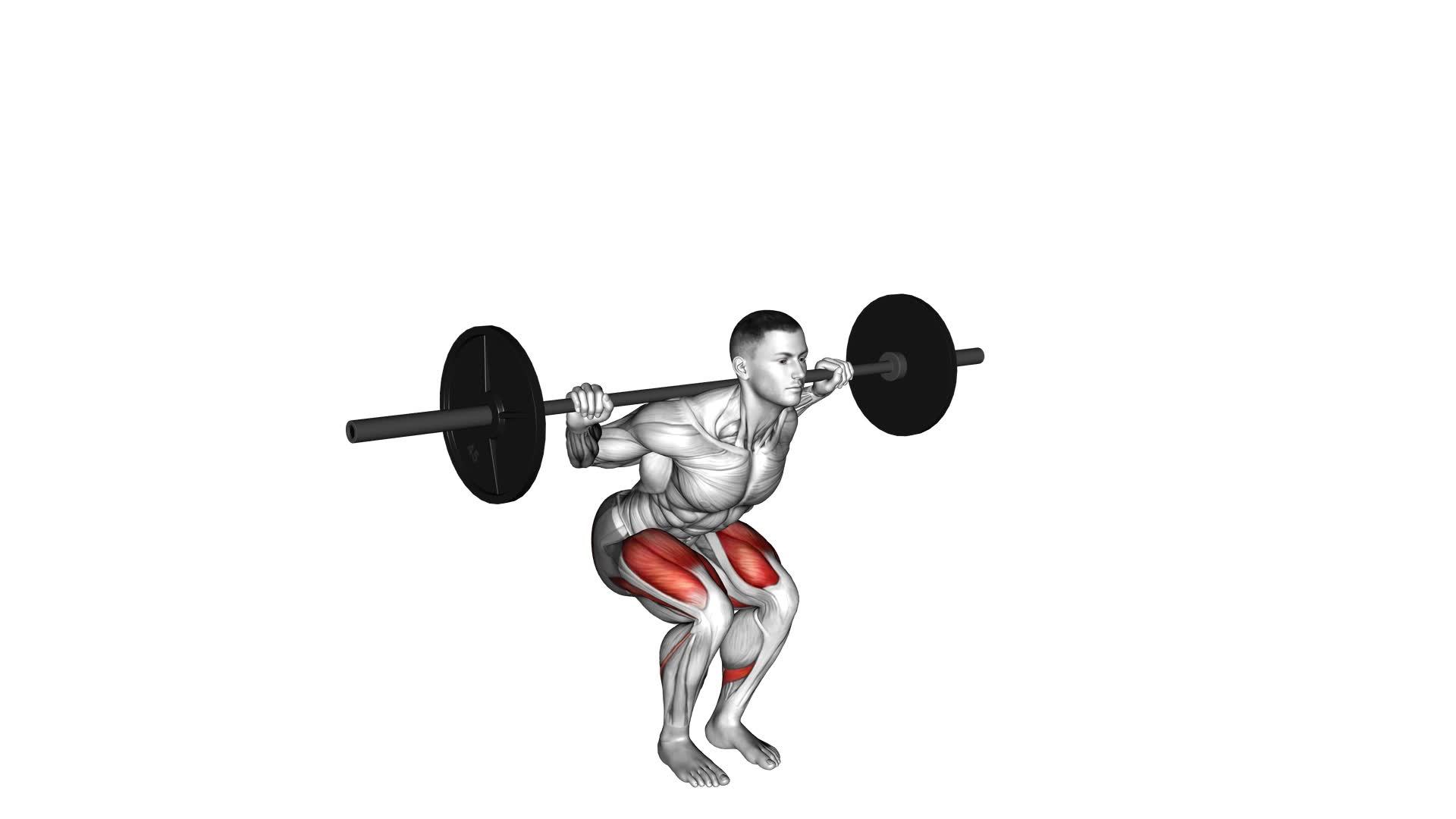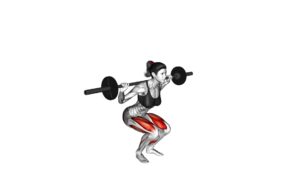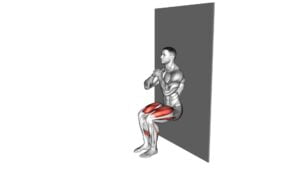Barbell Narrow Stance Squat (male) – Video Exercise Guide & Tips

In this video exercise guide, you'll learn how to properly perform the barbell narrow stance squat. This variation of the squat targets your lower body muscles, helping you build strength and improve your overall fitness.
Watch This Exercise Video
We'll show you the correct form and technique to maximize your results while avoiding common mistakes. If you're an advanced lifter, we'll also cover variations to challenge yourself further.
Get ready to increase your weight and intensity with these expert tips and stay safe with our injury prevention advice.
Let's get started!
Key Takeaways
- Barbell Narrow Stance Squat targets lower body muscles such as quadriceps, hamstrings, glutes, and core.
- Proper form and technique, including feet placement, posture, and breathing, are crucial to perform the exercise effectively and avoid injuries.
- Common mistakes to avoid include having a stance that is too narrow, not maintaining a neutral spine, rushing through the movement, lacking stability and control, and ignoring proper load distribution.
- Advanced variations of the Barbell Narrow Stance Squat, such as Barbell Front Squat, Barbell Overhead Squat, Pistol Squat, and Pause Squat, can further challenge the muscles and provide additional benefits.
Benefits of Barbell Narrow Stance Squat
Improve your lower body strength and stability with the benefits of the Barbell Narrow Stance Squat. This exercise targets multiple muscle groups, including the quadriceps, hamstrings, glutes, and core, making it an effective lower body strengthening exercise. By incorporating barbell narrow stance squat variations into your workout routine, you can further enhance the benefits and challenge your muscles in new ways.
One of the key benefits of the barbell narrow stance squat is its ability to improve lower body strength. By placing your feet closer together, you activate the muscles in your inner thighs and challenge your balance and stability. This exercise also helps to improve hip mobility and flexibility, allowing for better overall lower body function.
To perform an effective narrow stance squat, start by standing with your feet hip-width apart and your toes slightly turned out. Hold the barbell across your upper back, resting it on your traps or shoulders. Engage your core and begin to lower your body by bending at the hips and knees, keeping your chest up and your weight in your heels. Lower until your thighs are parallel to the ground, then push through your heels to return to the starting position.
Proper Form and Technique
To perform the barbell narrow stance squat correctly, ensure that your feet are positioned closer together and maintain proper form and technique throughout the exercise. Here are some important tips to help you execute this exercise effectively:
- Feet placement: Stand with your feet shoulder-width apart and turn your toes slightly outward. Bring your feet closer together, so they're about hip-width apart. This narrower stance will target your quads and glutes more intensely.
- Proper posture: Keep your chest up, shoulders back, and core engaged throughout the movement. This will help maintain a neutral spine and prevent any unnecessary strain on your lower back.
- Importance of breathing: Before you begin the squat, take a deep breath and brace your core. This will create intra-abdominal pressure and provide stability to your spine. Exhale as you push through your heels to stand back up.
- Bracing techniques: To further enhance stability, imagine pushing your knees outwards and engaging your glutes as you descend into the squat. This will activate your hip muscles and prevent your knees from collapsing inward.
Common Mistakes to Avoid
Now let's address the common mistakes to avoid when performing the barbell narrow stance squat.
Proper technique is crucial to maximize the effectiveness of this exercise and prevent injury. One common mistake is having a stance that's too narrow. It's important to find a stance that allows you to maintain stability and control throughout the movement.
If your feet are positioned too close together, it can cause your knees to cave inwards, which puts excessive stress on the knee joints.
Another mistake to avoid isn't maintaining a neutral spine. It's important to keep your back straight and avoid rounding or arching your back during the squat. This ensures that the load is properly distributed and reduces the risk of lower back injuries.
Lastly, rushing through the movement is a common mistake. It's important to perform the squat in a controlled manner, focusing on the proper range of motion and maintaining good form throughout.
Variations for Advanced Lifters
For advanced lifters, there are several challenging variations of the barbell narrow stance squat that can further enhance your strength and performance. These advanced squat variations and techniques will push your limits and help you achieve greater gains in your training.
Here are four variations to consider incorporating into your routine:
- Barbell Front Squat: This variation places the barbell in front of your body, challenging your core stability and upper body strength. By keeping the barbell in front, you'll engage your quadriceps, glutes, and core to a greater extent.
- Barbell Overhead Squat: This variation requires you to hold the barbell overhead while performing the squat. It demands exceptional shoulder mobility, stability, and core strength. The overhead squat targets your lower body, upper body, and core simultaneously, making it a highly effective full-body exercise.
- Pistol Squat: The pistol squat is a single-leg variation of the narrow stance squat. It requires exceptional balance, stability, and strength in your lower body. This advanced squat variation targets your quadriceps, glutes, and hamstrings while also engaging your core for stability.
- Pause Squat: In this variation, you pause at the bottom of the squat for a few seconds before returning to the starting position. The pause squat helps develop strength in the bottom position, increasing your explosiveness and stability.
Incorporating these advanced squat variations into your training can provide new challenges and help you break through plateaus. Remember to start with lighter weights and focus on proper form before progressing to heavier loads.
Tips for Increasing Weight and Intensity
To increase weight and intensity in your barbell narrow stance squat, there are several key points to keep in mind.
First, utilize progressive overload techniques by gradually increasing the weight you lift over time.
Second, focus on maintaining proper form and technique to maximize the effectiveness of the exercise.
Lastly, don't forget the importance of rest and recovery strategies to allow your muscles to adapt and grow stronger.
Progressive Overload Techniques
Increase the weight and intensity of your barbell narrow stance squat by implementing progressive overload techniques. Progressive overload is a key principle in strength training that involves gradually increasing the demands placed on your muscles over time. This strategy is essential for achieving optimal results and preventing plateaus in your workouts.
Here are four effective progression strategies that can help you implement progressive overload and maximize the benefits of your barbell narrow stance squat:
- Increase the weight: Gradually add more weight to the barbell to challenge your muscles and stimulate growth.
- Perform more reps: Aim to increase the number of repetitions you can perform with proper form.
- Decrease rest time: Shortening the rest periods between sets can increase the intensity of your workout.
- Change the tempo: Varying the speed at which you perform the exercise can add a new challenge to your muscles.
Proper Form and Technique
To properly increase the weight and intensity of your barbell narrow stance squat, focus on maintaining proper form and technique. The benefits of proper form can't be overstated when it comes to this exercise. By using the correct form, you engage the targeted muscles more effectively, reducing the risk of injury and maximizing your gains.
Proper technique is equally important, as it ensures that you're performing the exercise correctly and efficiently. It helps you achieve the desired range of motion and targets the intended muscle groups. Pay attention to your posture, keep your back straight, and lower your body until your thighs are parallel to the ground.
Push through your heels to stand back up, maintaining control throughout the movement. Remember, quality over quantity is key for optimal results.
Rest and Recovery Strategies
Now let's delve into how you can effectively increase the weight and intensity of your barbell narrow stance squat by implementing rest and recovery strategies. Rest and recovery are crucial for maximizing your progress and avoiding injuries.
Here are four strategies that will help you in your journey:
- Proper sleep: Getting enough sleep is essential for muscle recovery and growth. Aim for 7-9 hours of quality sleep each night.
- Active rest days: Incorporate light activities like walking or stretching on your rest days to promote blood flow and aid in recovery.
- Nutrition: Fuel your body with a balanced diet that includes sufficient protein, carbohydrates, and healthy fats. Proper nutrition supports muscle repair and growth.
- Foam rolling and stretching: Use foam rollers and stretches to release muscle tension and improve flexibility. This will enhance your squat performance and prevent muscle imbalances.
Safety Precautions and Injury Prevention
To ensure your safety and prevent injuries during the barbell narrow stance squat, it's crucial to maintain proper form. This means keeping your back straight, core engaged, and knees aligned with your toes.
Proper Form Importance
Maintaining proper form during the Barbell Narrow Stance Squat is crucial for preventing injuries and ensuring safety. When performing this exercise, it's important to focus on technique and maintain proper form to reap the benefits of this exercise.
Here are four reasons why proper form is of utmost importance:
- Injury Prevention: By maintaining proper form, you reduce the risk of injuries such as strains, sprains, and muscle imbalances.
- Effective Muscle Engagement: Proper form allows you to target the intended muscle groups effectively, maximizing the benefits of the Barbell Narrow Stance Squat.
- Stability and Balance: Maintaining proper form helps you maintain stability and balance throughout the movement, reducing the risk of falls or accidents.
- Long-term Progress: Consistently practicing proper form will lead to improved strength, endurance, and overall performance, allowing you to progress safely and efficiently.
By understanding the importance of technique and the benefits of proper form, you can ensure a safe and effective Barbell Narrow Stance Squat.
Now, let's delve into the common injury risks associated with this exercise.
Common Injury Risks
To ensure your safety and prevent injuries, it's important to be aware of the common injury risks associated with the Barbell Narrow Stance Squat.
When performing this exercise, there's a risk of straining your lower back or knees if not executed properly. To minimize these risks, it's crucial to focus on maintaining proper form and technique throughout the movement.
Start by warming up your muscles and joints with dynamic stretches. Engage your core and maintain a neutral spine position throughout the exercise. Keep your knees aligned with your toes and avoid excessive forward leaning.
Use a weight that allows you to maintain control and proper form. If you experience any discomfort or pain, stop immediately and consult with a professional for proper injury prevention and rehabilitation techniques.
Frequently Asked Questions
How Often Should I Include the Barbell Narrow Stance Squat in My Workout Routine?
To maximize the benefits of the barbell narrow stance squat, you should include it in your workout routine at least twice a week.
This exercise targets your quadriceps, glutes, and hamstrings, helping to strengthen and build muscle in your lower body.
By incorporating the barbell narrow stance squat into your routine, you can improve your overall lower body strength and power, leading to increased athletic performance and functional movement.
Remember to start with lighter weights and gradually increase the load as you become more comfortable with the exercise.
Can the Barbell Narrow Stance Squat Help With Improving My Balance and Stability?
To improve your balance and stability, incorporating the barbell narrow stance squat into your workout routine can be highly beneficial.
This exercise requires you to maintain a narrow stance while squatting with a barbell, which helps engage and strengthen the muscles responsible for stability.
What Are Some Alternative Exercises That Can Complement the Barbell Narrow Stance Squat?
Looking to complement the barbell narrow stance squat? There are several alternative exercises that can be beneficial.
One option is the goblet squat, which can help improve your squat form and target your quads.
Another option is the Bulgarian split squat, which can enhance balance and stability.
Additionally, the single-leg squat can strengthen your legs and core.
Incorporating these exercises into your routine can provide variety and help you maximize the benefits of the narrow stance squat.
Is It Necessary to Use a Weightlifting Belt While Performing the Barbell Narrow Stance Squat?
Using a weightlifting belt during the barbell narrow stance squat is a personal preference. It can provide benefits such as increased intra-abdominal pressure and stability, reducing the risk of injury.
However, there are also potential downsides, such as relying too much on the belt and neglecting core strength development.
Ultimately, it's important to consider your individual needs and goals when deciding whether to use a weightlifting belt for this exercise.
Are There Any Specific Breathing Techniques That Should Be Used During the Barbell Narrow Stance Squat?
During the barbell narrow stance squat, proper breathing techniques are crucial for maximizing performance and safety. By taking a deep breath in before descending into the squat and exhaling forcefully on the way up, you engage your core, stabilize your spine, and generate more power.
This technique helps maintain proper form, prevents injury, and enhances overall lower body strength. Incorporating specific breathing techniques into your barbell narrow stance squat routine can greatly improve your workout experience and results.
Conclusion
In conclusion, the barbell narrow stance squat is a highly effective exercise for targeting the lower body muscles. By maintaining proper form and technique, you can maximize the benefits of this exercise while avoiding common mistakes.
Advanced lifters can explore variations to challenge themselves further, and by gradually increasing the weight and intensity, you can continue to progress.
Remember to prioritize safety and follow injury prevention measures to ensure a successful and injury-free workout.

Author
Years ago, the spark of my life’s passion ignited in my mind the moment I stepped into the local gym for the first time. The inaugural bead of perspiration, the initial endeavor, the very first surge of endorphins, and a sense of pride that washed over me post-workout marked the beginning of my deep-seated interest in strength sports, fitness, and sports nutrition. This very curiosity blossomed rapidly into a profound fascination, propelling me to earn a Master’s degree in Physical Education from the Academy of Physical Education in Krakow, followed by a Sports Manager diploma from the Jagiellonian University. My journey of growth led me to gain more specialized qualifications, such as being a certified personal trainer with a focus on sports dietetics, a lifeguard, and an instructor for wellness and corrective gymnastics. Theoretical knowledge paired seamlessly with practical experience, reinforcing my belief that the transformation of individuals under my guidance was also a reflection of my personal growth. This belief holds true even today. Each day, I strive to push the boundaries and explore new realms. These realms gently elevate me to greater heights. The unique combination of passion for my field and the continuous quest for growth fuels my drive to break new ground.







